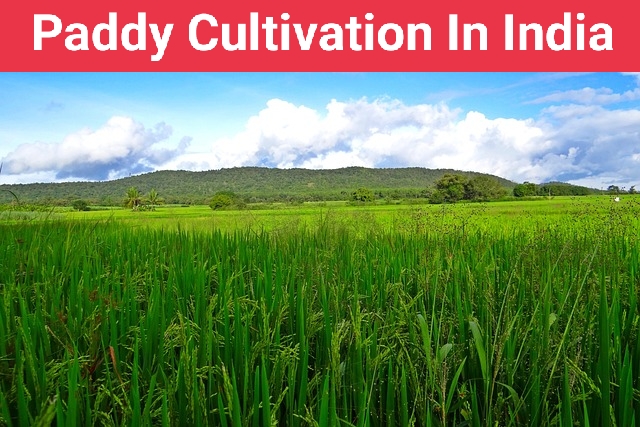Paddy Cultivation In India: Friends, most of the people in India like to eat rice very much. In such a situation, the profit from paddy cultivation is also very high. If you also want to know how to do paddy cultivation, then you have come to the right place. In today’s special article, I am going to give you all the information related to paddy cultivation here. So do read this post till the end. You will get all the information related to paddy cultivation like soil, climate, fertilizer, and how much water is required for paddy cultivation. Paddy cultivation is done maximum in West Bengal of India. 13.62% of the total paddy production in India is done only in West Bengal.

Friends, after maize, if any other crop is cultivated the most in the whole world, then it is paddy. People eat the rice obtained from paddy with great enthusiasm. Paddy is a kharif crop that is cultivated in almost every country. Paddy cultivation is also done on a large scale in India. China ranks first in the production of paddy in the whole world and India ranks second. Paddy cultivation in India is mainly done in states like West Bengal, Haryana, Bihar, Uttar Pradesh, Andhra Pradesh, Punjab, and Tamil Nadu. It is said that the cultivation of paddy started in India 5,000 years ago in the northern region.
Paddy Plant Details
Rice belongs to the grass species. The scientific name of the paddy plant is Oryza sativa. People all over the world eat it as a staple food and grain. Rice is one of the most important food items for nutrition and caloric intake. Rice is a monocot and tropical plant. Paddy is mainly cultivated in places with high rainfall because it requires more water for its cultivation. The paddy plant is 4 to 6 feet tall. Its leaves are long and the width is very less. The length of the leaves can be up to 100 cm and they are up to 2 cm wide. Its cultivation is started during the months of April and June. And paddy plants are ready by August-October.
How to Cultivate Paddy
Friends, many farmers do paddy farming, but for high yield, farmers have the knowledge of modern techniques. It is very important for the farmers to know everything related to paddy cultivation so that by selecting advanced varieties of paddy, it can be cultivated properly by examining the soil of the field and the climate of the place where farming is being done. If the farmers take care of all these things, then definitely the production of crops will increase.
Also, Read What is Manure and Fertilizer
Best Varieties for Paddy Cultivation
- Danteshwari Paddy
- Pusa 1460
- Pusa Fragrance 3
- Pusa Fragrance 4
- WGL 32100
- DRR Paddy 310
- Malviya Paddy
- Sarju-52
- Pusa-44
- Narendra Usar Paddy-3
The right way of Paddy Cultivation
Before sowing paddy, you have to do deep plowing of the field. Keep in mind that the residues of old crops should be removed from the field properly. Now apply plenty of water in the field. After a few days, plow the field again and make it level. Now you have to make dams in the field so that water can be stored properly during the rainy season. You also have to keep in mind that only green manure and phosphorus should be used at the time of sowing.
Also, Read Goat Farming Business in India 2023
Rice seed sowing
Suppose you want to cultivate paddy in a 1-hectare field, then you will need 35 to 45 kg of seeds. Paddy is sown before the monsoon so that the need for irrigation after sowing is less. In India, it is mainly sown during the month of June because it is the monsoon season. At the time of sowing of paddy, the proper amount of water is required in farming. However, in some states of India, sowing is also done in dry fields. Let me tell you that different varieties of paddy are sown in dry fields. In non-irrigated conditions, varieties of paddy like Saket-4, Barani Deep, etc. are sown. So in this way, the cultivation of paddy is started.
Also, Read What is Organic Farming
Fertilizers for Paddy Cultivation
Let me now tell you which fertilizers will be required for paddy cultivation. Fertilizers are very important for good yield. After you have planted paddy, then fertilizer should be applied in the field. But keep in mind that do not put urea in excess in the paddy field, it can ruin the paddy crop. For good productivity of paddy, you have to use DAP, MOP, Zinc, etc. in the field. 30 kg Urea, 90 kg DAP, 25 kg Zinc, and 60 kg MOP are sufficient for the 1-hectare farm. Manure should be applied in the fields only after 1 month of paddy transplanting.
Also, Read Pineapple Cultivation in India
Paddy Irrigation
You must also know that frequent irrigation is required in paddy crops. Therefore, it is necessary to make dams in the fields and fill them with water. For proper growth and good productivity of plants, regular irrigation should be done so that there is no shortage of water.
Paddy Crop Diseases and Prevention
Friends, whatever the crop or insects do appear, in such a situation, proper care of paddy is essential. Paddy fields are mainly affected by diseases like Badra, Brown spot, Stem rot, Sheath rot, etc. It is necessary to prevent these diseases as soon as possible for a good crop. The crop can be saved from diseases by spraying medicines at the right time.
Through this article, I have given you complete information about paddy plants and paddy cultivation. If you want any other information related to paddy cultivation, then please tell us through comments.
Also, Read Saffron Cultivation In India 2023

[…] Also, Read Paddy Cultivation In India | Business Sense […]